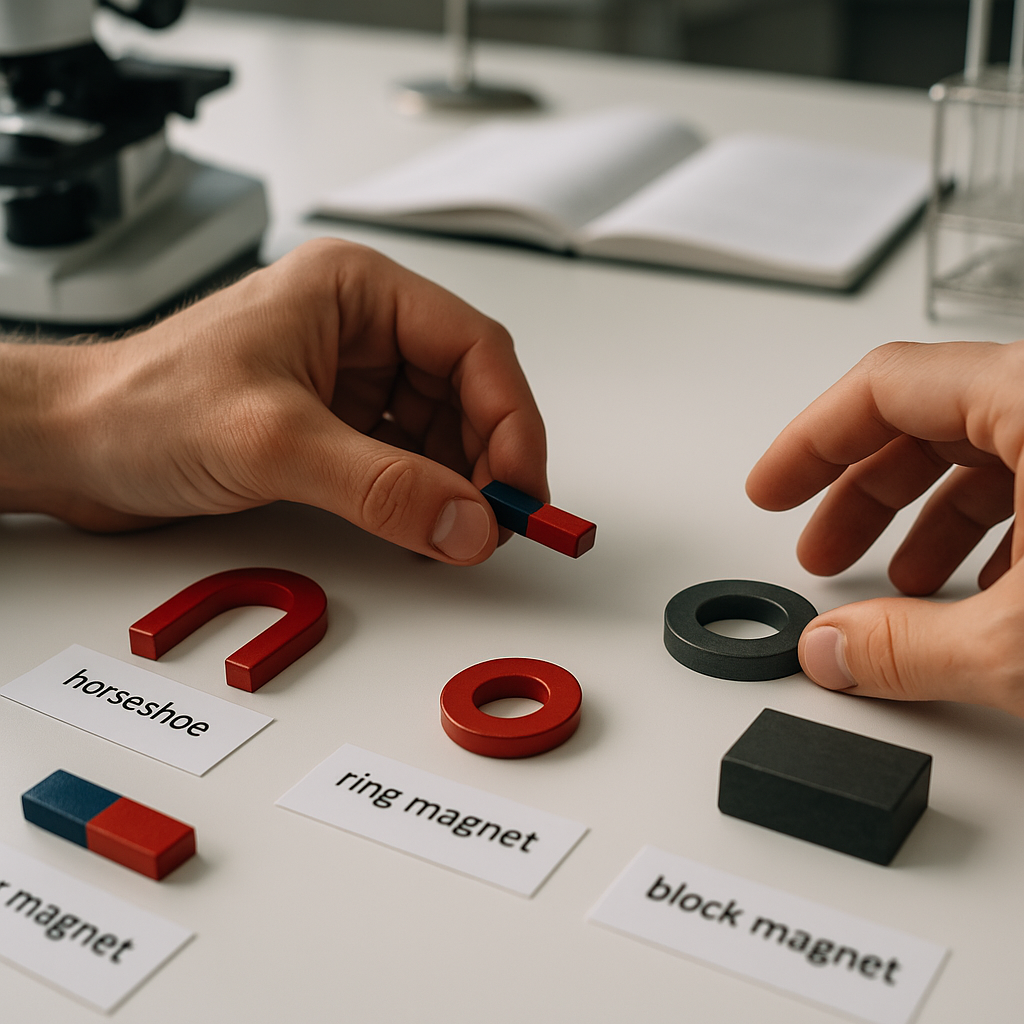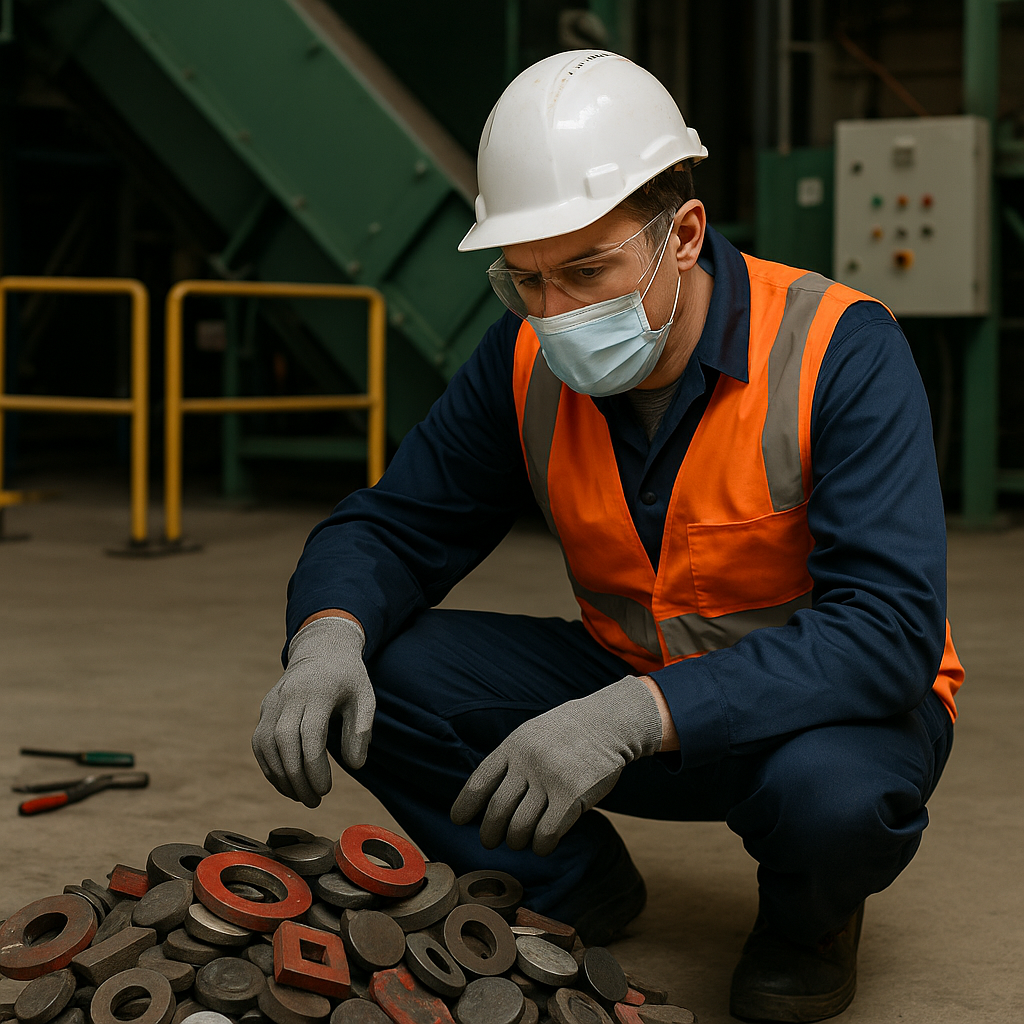5901 Botham Jean Blvd, Dallas, TX 75215
Magnet Recycling for Cash: How to Identify, Sell, and Profit from Rare Earth Scrap Magnets
September 3, 2025Recycling magnets for cash is an emerging opportunity within the waste management sector. This involves collecting and selling scrap magnets containing valuable rare earth metals to specialized recycling facilities. By doing so, important materials are kept out of landfills, providing a financial incentive for participants.
The most valuable magnets for recycling are those containing rare earth elements like neodymium, praseodymium, dysprosium, and terbium. These elements are critical components in modern technologies but have a limited supply. Currently, less than 1% of rare earth magnets are recycled, with most ending up in landfills.
Magnets suitable for recycling come from various sources, including electronics like hard drives and speakers, electric motors, industrial equipment, wind turbines, and various household appliances. The recycling process typically involves demagnetizing the materials first, making them easier to handle and process for material recovery.
How Do You Identify Recyclable Magnets?

Identifying recyclable magnets requires understanding the key difference between ferrous and non-ferrous metals. This classification not only influences the recycling method but also the potential value of your scrap.
The magnet test is the quickest and most reliable way to identify recyclable magnetic materials. This straightforward method requires only a common household magnet to determine whether your scrap has valuable materials.
The Magnet Test: A Simple Identification Method
The magnet test works on a basic principle: ferrous metals contain iron and will attract a magnet, whereas non-ferrous metals lack iron and will not. Here’s how to perform the test:
- Use any magnet from your home (a refrigerator magnet works well)
- Touch the magnet to the metal item you want to recycle
- Observe the reaction between the magnet and the metal
- If the magnet sticks firmly, you have ferrous metal
- If the magnet doesn’t stick, you’ve identified a non-ferrous metal
This test helps determine whether your recyclable magnets contain ferrous metals like steel and iron or non-ferrous metals such as copper and aluminum. Non-ferrous materials typically command higher prices in recycling markets due to their greater scarcity and valuable properties.
Understanding Ferrous Magnetic Materials
Ferrous metals primarily consist of iron. These materials are magnetic and generally more abundant. While they often fetch lower prices at recycling facilities, they remain crucial in the recycling stream.
Ferrous materials tend to be heavier for their size, may develop reddish-brown rust over time, and always respond to a magnet. Common examples include carbon steel, cast iron, and wrought iron. These metals form the backbone of many industrial applications due to their strength and durability.
Identifying Non-Ferrous Magnetic Materials
Non-ferrous metals lack iron content. They won’t stick to a standard magnet and generally resist corrosion better than ferrous metals. Their resistance to rust and lightweight nature makes them valuable for specialized applications.
Interestingly, some magnetic materials fall into the non-ferrous category. Rare earth magnets, containing elements like neodymium, are technically non-ferrous despite their strong magnetic properties. These specialized magnets command premium prices in recycling markets due to their valuable components.
Common Sources of Recyclable Magnets
Recyclable magnets are found in many everyday and industrial items. Common sources include:
- Electronic devices (hard drives, speakers, headphones)
- Household appliances (refrigerators, washing machines)
- Industrial equipment (motors, generators)
- Automotive parts (starters, alternators)
- Power tools (drills, saws)
- Medical equipment (MRI machines)
When collecting recyclable magnets, focus on these sources. Magnets in electronic waste often include valuable rare earth elements, making proper recycling essential.
Proper identification is key to maximizing the value of recyclable magnets. Clean, well-sorted materials always command better prices at recycling facilities. Remove attachments or coatings when possible to ensure the highest return for your recyclable materials.
| Property | Ferrous Metals | Non-Ferrous Metals |
|---|---|---|
| Composition | Contains iron | Does not contain iron |
| Magnetic Properties | Magnetic | Generally not magnetic (some exceptions like rare earth magnets) |
| Corrosion Resistance | Less resistant to corrosion | More resistant to corrosion |
| Density | Heavier | Lighter |
| Common Examples | Carbon steel, cast iron, wrought iron | Aluminum, copper, brass, zinc |
By using the simple magnet test and understanding the differences between ferrous and non-ferrous materials, you can maximize the value of your recyclable magnets while contributing to resource conservation.
Where Can You Sell Magnets for Recycling?
If you’re looking to recycle magnets for cash, Okon Recycling stands out as the premier partner—from collection to return value and environmental responsibility.
Top-Rated Recycler of Rare Earth Magnets
Okon Recycling is North America’s largest recycler of scrap neodymium (neo) magnets and MRI magnets. Their advanced facility specializes in safely processing and recovering valuable rare earth materials for reuse or resale to OEMs.  
Cutting-Edge Processing with Maximum Reuse
Their state-of-the-art magnet processing facility is among the most sophisticated in the world. Okon can either recut scrap neodymium magnets or convert them into rare earth oxides. Many OEM clients even reuse these materials directly in highly technical new equipment. 
Traceable, Purpose-Built Recycling in Dallas, TX
Located at 5901 Botham Jean Blvd in Dallas, TX, Okon operates a fully permitted, 20-acre recycling campus. Designed for efficiency, safety, and scale, the facility is well-equipped to handle both residential drop-offs and large commercial streams. 
Eco-Conscious and Regulatory-Compliant
Okon’s magnet recycling methods—like hydrometallurgy and hydrogen decrepitation—minimize environmental impact while recovering high-purity rare earth elements. These sustainable practices reduce the need for destructive mining and keep rare earths out of landfills. 
What are the Challenges in Magnet Recycling?

Recycling magnets containing rare earth elements presents significant hurdles for the recycling industry. Addressing these complex challenges requires innovative solutions to make recycling both environmentally and economically viable.
The first major obstacle is extracting magnets from end-of-life products. These magnets are often deeply embedded within devices, making their removal labor-intensive and costly. In consumer electronics and appliances, magnets are typically small and integrated into complex assemblies, requiring specialized dismantling techniques.
Traditional recycling methods are poorly equipped to handle rare earth magnets. When devices are shredded during conventional recycling processes, valuable magnets can end up in ferrous metal streams and are ultimately lost as slag in iron smelters, representing a waste of critical materials.
Technical and Economic Barriers
The recycling process itself poses technical challenges once magnets are extracted. Separating and purifying rare earth elements requires sophisticated metallurgical processes due to their similar chemical properties. Current methods include hydrometallurgical processes that use aqueous solutions to dissolve and separate valuable elements, albeit resource-intensive.
The economic viability of recycling fluctuates with market conditions. When prices for virgin rare earth materials drop, recycling becomes less financially attractive despite its environmental benefits. This volatility makes it difficult for recycling operations to plan long-term investments in specialized equipment and processes.
Collection infrastructure presents another obstacle. Less than 1% of rare earth elements are currently recycled globally, partly due to inadequate collection systems for end-of-life products containing these materials. Without sufficient feedstock, recycling operations cannot achieve the economies of scale needed to reduce costs.
Emerging Solutions
Despite these challenges, promising technological developments are emerging. Advanced separation technologies are being developed to more efficiently isolate rare earth elements from recycled materials. Automated disassembly systems using robotics show potential for reducing the labor costs associated with magnet extraction.
Hydrogen decrepitation represents an innovative approach that breaks down magnet structures at the atomic level, making separation of rare earth elements easier and potentially reducing the need for intensive chemical treatments. Though still in early development stages, this method shows promise for large-scale applications.
Regulatory frameworks are also evolving to support rare earth recycling. Extended producer responsibility policies and restrictions on exporting electronic waste can help ensure more devices are collected and processed domestically, creating a more stable supply of recyclable materials.
The future looks more promising for rare earth magnet recycling as the scrap pool shifts. While current challenges focus on small magnets in consumer electronics, future opportunities will include larger magnets from electric vehicles and wind turbines. These larger magnets contain higher concentrations of valuable heavy rare earth elements and present fewer dismantling challenges.
| Challenges | Solutions |
|---|---|
| Technical Complexity | Development of specialized dismantling techniques and advanced separation technologies. |
| High Cost of Extraction | Use of automated disassembly systems and hydrogen decrepitation methods to reduce costs. |
| Contamination of Materials | Improved processes for separating and purifying rare earth elements like hydrometallurgical processes. |
| Inadequate Collection Systems | Implementation of extended producer responsibility policies and increased recycling infrastructure. |
| Volatility of Market Prices | Developing cost-effective recycling processes and innovative business models to enhance economic viability. |
As technologies improve and economies of scale are achieved, the economic viability of recycling is expected to rise. Companies developing cost-effective processes and innovative business models aim to make rare earth magnet recycling not only environmentally beneficial but also economically attractive.
Conclusion: The Future of Magnet Recycling

Magnet recycling for cash offers a significant opportunity at the intersection of environmental sustainability and economic benefit. Our exploration has shown that the growing demand for rare earth metals in various industries—from electric vehicles to wind turbines—has created a viable market for recycled magnetic materials. Financial incentives for recycling magnets continue to strengthen as technologies advance and rare earth element supplies face increased pressure.
The economic analysis of recycled magnet materials reveals promising value. Research indicates that rare earth elements recovered from magnets can bring substantial market value, with elements like neodymium, dysprosium, and praseodymium commanding premium prices. As recycling processes become more efficient and widespread, the cost-effectiveness of magnet recycling is likely to improve, increasing profitability for participants across the supply chain.
For more information about recycling magnets and other materials for maximum environmental and financial benefit, contact Okon Recycling at 214-717-4083.
